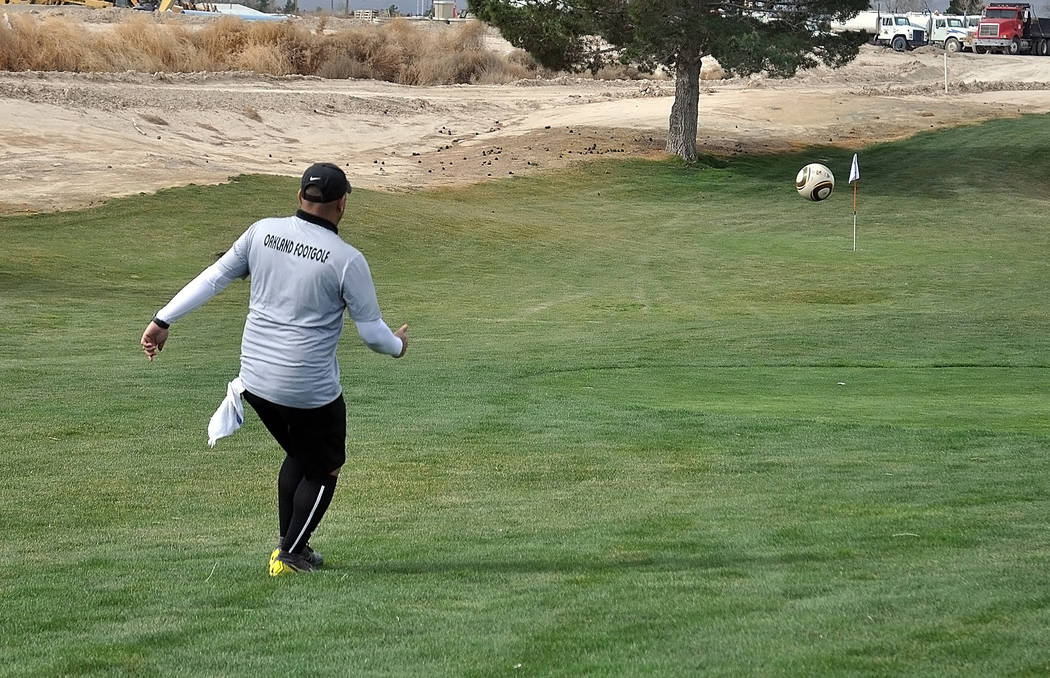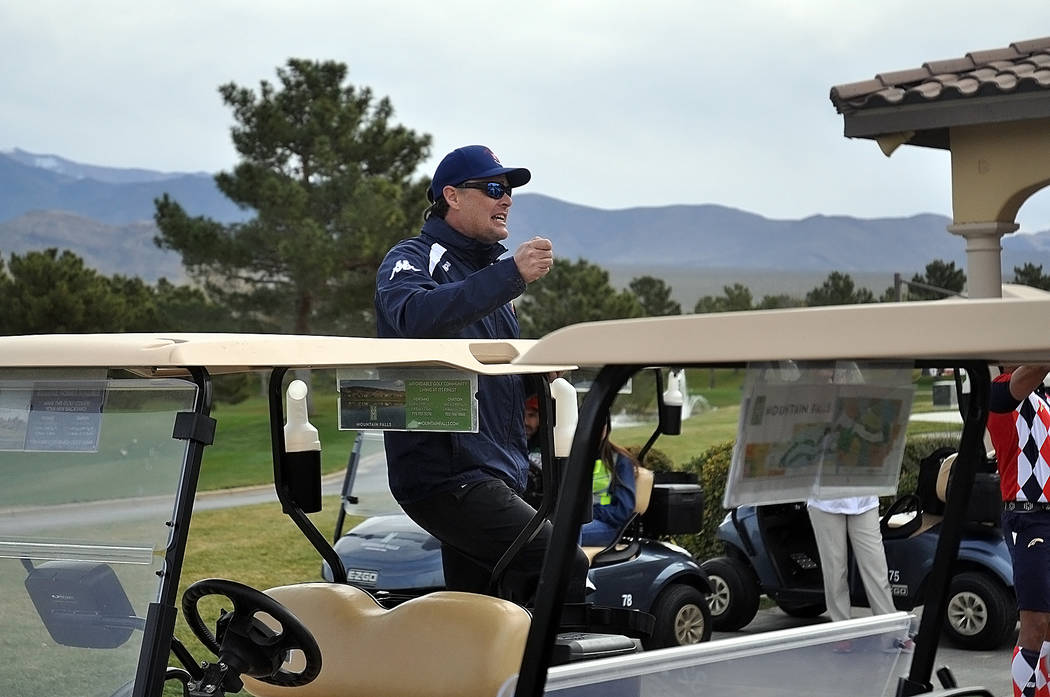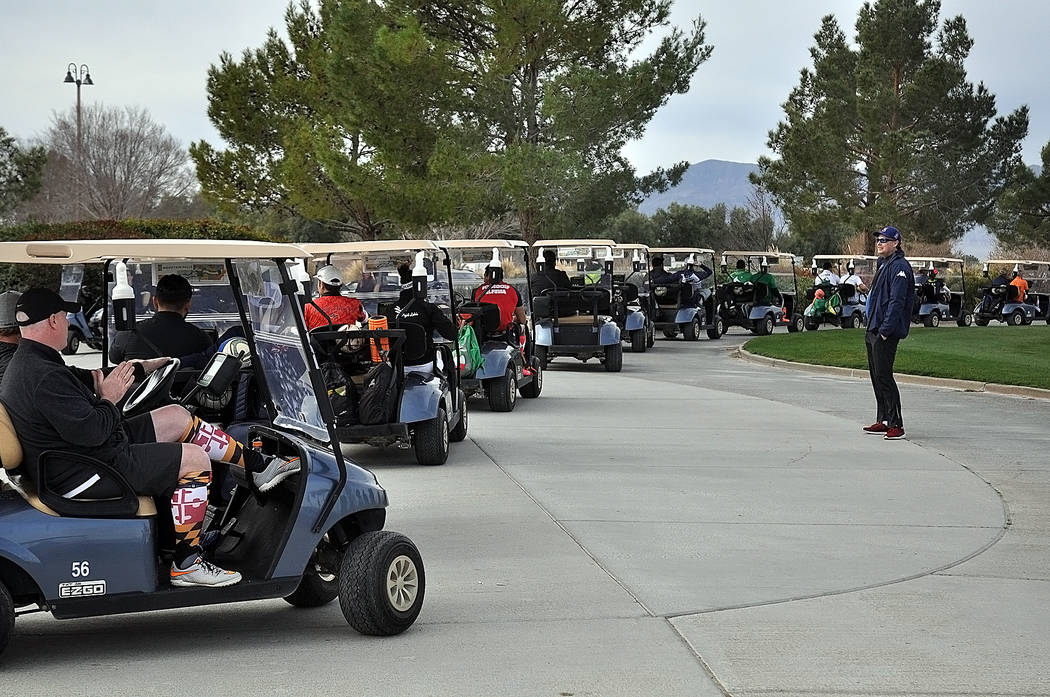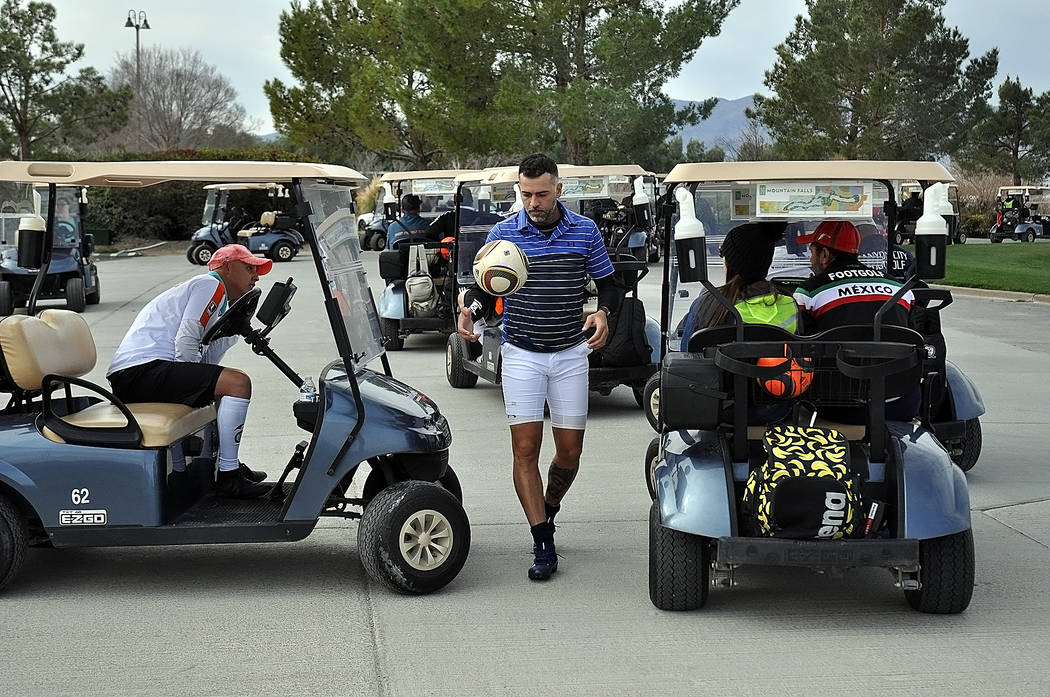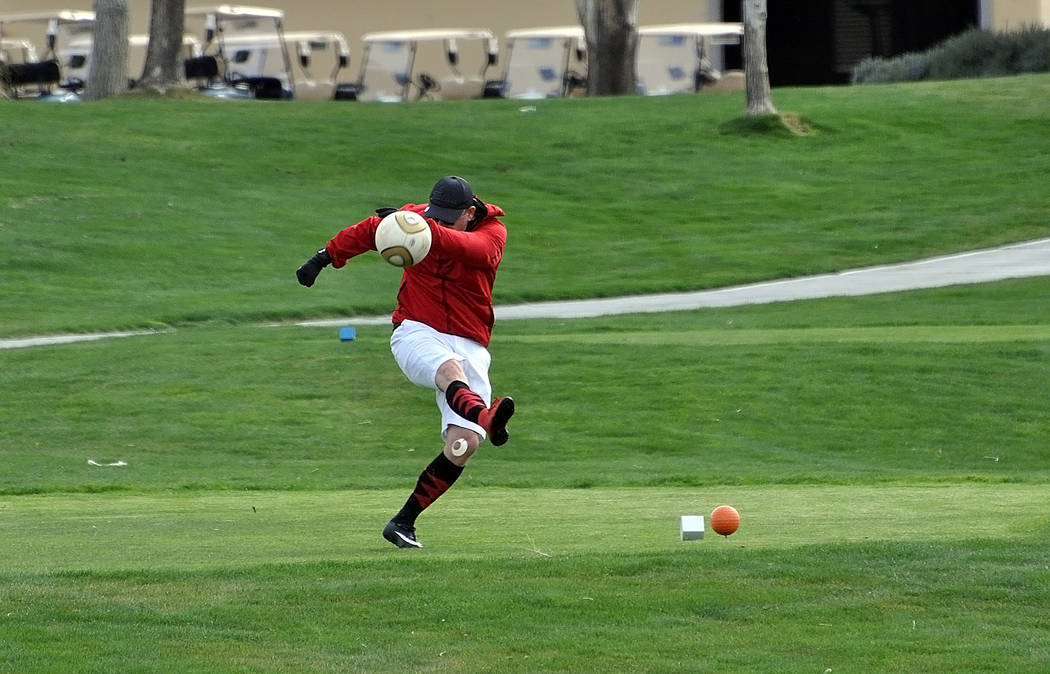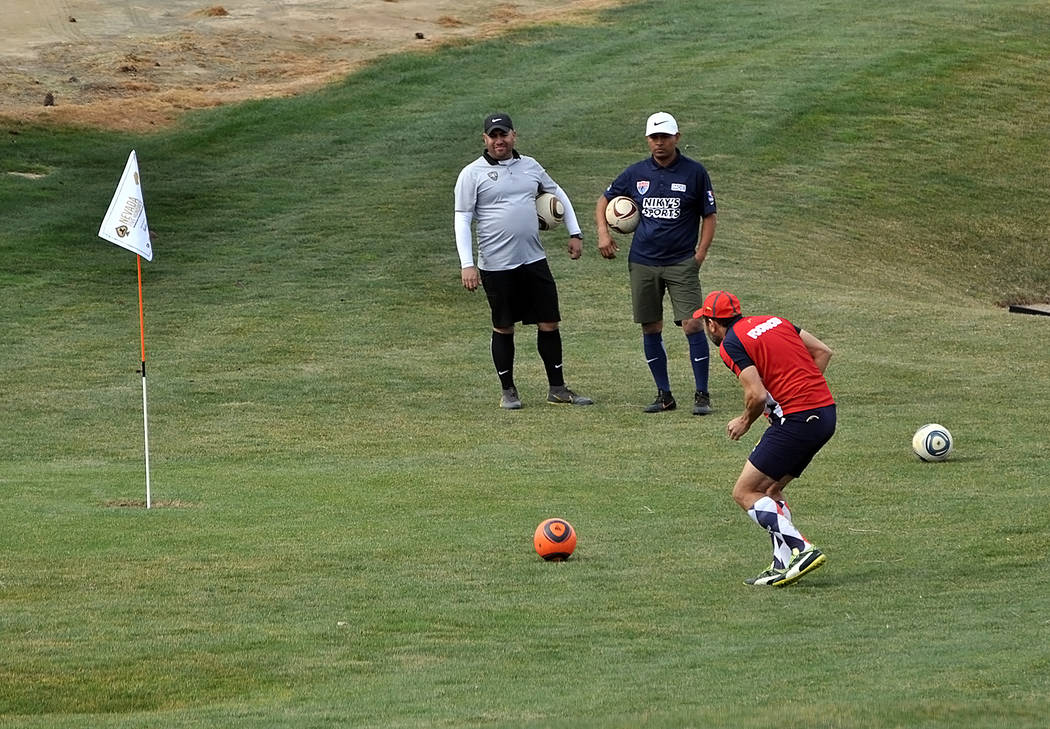Mountain Falls welcomes footgolf to Pahrump
A battalion of golf carts were lined up outside the pro shop at Mountain Falls Golf Course on Saturday morning, waiting for competitors who, unlike in many tournaments, would be allowed to ride.
The tour director, Robert Greer, shouted instructions, talking about what made a ball out of bounds and how to handle construction areas along the course. It all seemed like routine activity for a golf course hosting a major event.
When the tour director was content that the players had no further questions or concerns, he sent them on their way. Players climbed into their carts and head out to the course, soccer balls in hand.
Yes, soccer balls. For this was the first leg of the Nevada 500, part of the American FootGolf League tour. And the American tour is part of a global sport governed by the Federation for International FootGolf.
“The FIFG has 38 countries around the world, and there are different stops around the world on the tour,” explained Laura Balestrini, the CEO of the AFGL. “This is a 500-point event, which is the second highest.”
And that means the Nevada 500 drew 86 footgolfers — 56 men, 23 seniors and seven women — from all over the world to Pahrump. Gyorgy Podusil flew in from Hungary specifically to play in the tournament, one of the 30 to 35 he plays in each year.
“After two or three times, I was not good,” he said of his start in the sport. “Just not good. But I played with good friends, and I got better.”
Indeed he did; Podusil shot 11 under par during a bogey-free round at Mountain Falls and, coupled with a 7-under during Sunday’s second round at Chimera Golf Club in Henderson gave him second place in the tournament, trailing only Jordan Godfrey’s 21-under.
Godfrey didn’t travel quite as far as Podusil. Godfrey plays with the West Coast FootGolf Club based in Los Angeles, which has won the U.S. club title four times and had seven members on Team USA in 2016, which won the World Cup in Argentina.
That nation was represented in the Nevada 500 by Gonzalo Novosad, who has been playing footgolf for less than a year.
“The first time I tried it, I got addicted to it,” Novosad said through an interpreter, who happened to be AFGL Chairman Roberto Balestrini, Laura’s affable husband.
Novosad said he played approximately 25 tournaments in his first year on the tour, and listed their locations: “The USA, Argentina, Brazil, Italy, Germany, the UK, Wales, Portugal, and now Pahrump!”
Novosad is no stranger to Southern Nevada.
“This is my sixth year in a row, the past five years I came for the poker world cup, and now for footgolf,” he said. “This is much better than poker.”
Helping to make it better was his first-round score of 15-under. “I think I’ll be in the top three,” he said.
Novosad was on the money; he matched Podusil at 18 under.
Native Scot Derek Mills, a London resident, was making his first trip to Nevada, and he is among a large group of footgolfers with soccer backgrounds. Mills played professionally with Glasgow Celtic and now spends his retirement traveling to play footgolf 30 to 40 times each year, listing Argentina, Japan, Morocco, France, Holland, Spain and the United States among his destinations.
“I saw it on the internet three or four years ago and thought this was the perfect pastime for me,” Mills said while on his way to sixth place in the senior division. “I like golf, I like soccer, and I’m much better at soccer than golf. This game uses golf strategy and soccer skills.
“I’m retired now, so I travel all over the world playing this. You meet great people, great competition, you get to play with vistas like this. I love it.”
Sport seeking exposure
Mills sees a bright future for the sport, which for the moment is trying to break through the crowded sports media landscape.
“I think the media these days is dominated by so many other sports there’s not enough room for this,” he said. “In the U.K., 90 percent of the media is soccer, and then you’ve got tennis, rugby, golf, motor racing squeezed into the rest of it. But given how many golf courses there are in the world and how many play soccer, it’s inevitable it’s going to grow.”
That’s music to the ears of Laura Balestrini, who looks forward to the day people at home can watch footgolf tournaments.
“ESPN is Disney, and one of the courses we’re using is Disney, so we’re hoping,” she said. “They’ve got pre-footage shot from when we there for a tournament a couple of years ago.”
But would footgolf register on the radar of the people who make decisions at the network?
“I’ve seen cornhole on ESPN,” she said.
While footgolf has not exactly swept the nation, it certainly is growing at a steady pace. Footgolf began in the Netherlands in 2008 and arrived in the United States three years later.
“My husband and I started this here in 2011,” Balestrini said. “We had seen it being played out of Argentina. They had a show about it, we knew the producer, we called and here we are.”
“Here” means approximately 2,000 players on the tour and tens of thousands that play every month on the more than 500 footgolf courses in the United States. Mountain Falls has had a footgolf course for the past year.
“We just started it last year,” said Randy Mudge, the general manager and director of golf at Mountain Falls. “It didn’t take us that long to set it up. There’s not much more maintenance.”
Mudge said there has been some local interest in footgolf, although the sport is still in its infancy here.
“We’ve had a little bit, we’re hoping after this we get some more publicity about it,” he said. “We’re hoping for lots more because it’s something the whole family could do. In two hours, they can play 18 holes of footgolf.”
“He was definitely for putting it in,” Laura Balestrini said of Mudge. “On one of the courses he was at before, he was getting ready to put it in, and then he left. So when he got here he had been watching it for a few years.
“The biggest issue that we have is realizing that when it comes to where that hole is placed they need to be thinking golf. It needs to be flat, it needs to maybe have a little bit of roll in it. And your tee box locations, same thing. These guys are running up on that ball, and they can’t have uneven ground where they’re going to be twisting an ankle. It’s really important that we get the buy-in from the superintendent so they realize what the players are looking for.”
A boon for course owners?
Any effort to accommodate footgolf is well worth it for the courses, the Balestrinis believe.
“It’s great for fundraisers, team building, things like that,” Laura Balestrini said. “At a corporate outing you might have 20, 25% who play golf. If you add footgolf to a golf outing, suddenly everybody at the event can play.”
“The golf industry is doing everything to grow the game of golf,” Roberto Balestrini said, noting that in many places golfers are often Baby Boomers. In fact, the average age of golfers in the United States is 54. “The golf course operators are heroes in the industry, people who invest millions to open the door for players to play, and they need to keep those doors open. They found in this European sport, footgolf, the possibility to introduce new faces to their facilities. They welcome them, and now people who have never been on a golf course before are spending time and money in golf course facilities.
“They take full advantage of the real estate with an activity that requires no extra maintenance and generates new income. How many people who live 10 minutes away never drop a penny in this facility and never enjoy this beauty? Now, with a soccer ball, we bring those people and they can enjoy this. Mom and Pop play golf, and the kids play footgolf.”
That’s another plus for footgolf in the eyes of course operators: Golf and footgolf can be played simultaneously. For the Nevada 500, the 18 holes were laid out over the first nine holes at Mountain Falls, while golfers were sent out to start on No. 10.
“It doesn’t interrupt the golf play at all,” Laura Balestrini said. “We’re not playing on the greens of the golf course. The holes are usually on the edges of the fairways and the fringes of the greens.”
She said the holes are 53 centimeters in diameter, or about 21 inches. That makes the ratio of soccer ball to football hole the same as the ratio of golf ball to golf cup.
“We use the same tees as the golfers do unless they are setting up 18 holes of footgolf within 9 holes of golf,” she said. “The reason why they do that is to keep the pace of play the same between the golfers and the footgolfers.
“They don’t have to shut down. It’s a way to add additional rounds and additional revenue to a golf course.”
That’s additional rounds and additional revenue without even being noticed sometimes.
“We’ve done a tournament before where I’ve had one of the people who lived on the course walk up to me and say, ‘Did you guys just come in here last night and build this course?’ No, it’s been here for three years,” Laura Balestrini said. “That tells you it’s not interfering with their golf play.”
Of course, with many people not yet familiar with footgolf, sometimes players will get stares.
“What I like to see is the look of the golfers watching them,” Laura Balestrini said. “We’re going to have these soccer players running around the golf course, and then they watch them and they’re really good and really accurate and can kick the ball really far.”
Nobody’s getting rich — yet
Sometimes too far, or at least too far off course. On No. 18 (No. 9 for golfers), a water hazard to the left of the fairway became home to a ball, which is more of a problem than you might think.
“The balls these guys are playing with are an Adidas ball that’s not made any more,” she explained. “They pay $300 to $500 for a ball, and most of them carry two because you only have so long if your ball ends up in the water to retrieve it. You have to play with a replacement until it can be retrieved.
“When we’re rolling it through that rough, that’s dangerous, especially around here. You could hit a cactus thorn or something.”
Players have been known to spend well more than $1,000 for a ball, although recreational players can use any soccer ball they might have on hand. With little sponsorship and small purses, paying for a ball to use on the tour is not a laughing matter.
“The players are from all walks of life,” Laura Balestrini said. “We have doctors and lawyers. That group back there, one is a videographer in Hollywood, another owns a construction company. And I have players who drive Uber to make it from one tournament to the next. They’re all passionate.
“They are mostly self-sponsoring. There is very little sponsorship in the sport. Some are finding their own local sponsors. Some of the countries are starting to find bigger sponsorship for some of the larger tournaments.
“The cash purse is $3,000 on this one. The one that would be the U.S. Open is going to be at Panama City Beach in Florida, and that will have about a $12,000 cash purse. We have done a $25,000 cash purse, but it was getting too expensive without sponsors.”
The U.S. Open? Yes, just as in golf and tennis, footgolf has majors and a ranking system based on points. Defending national champion Angel Reyes, who also won the title in 2016, was among the footgolfers at Mountain Falls on Saturday.
“I’m originally a soccer player,” said Reyes, a youthful 36-year-old from Southern California. “Friends brought me, and they stopped inviting me after we played the first time. I play regular golf as well, so I was able to read the fairways and the greens.”
Reyes did well again last weekend, shooting 12 under Saturday and winding up fourth, 1 shot behind Podusil and Novosad.
“I think the hardest part is teeing off, because you need a strong leg to clear the first slope or the sand traps,” Reyes said.
Despite his background, Reyes, who last year won two titles, finished second twice and tied for third in another tournament, plays in a way considered blasphemy by other soccer players.
“My choice — which a lot of my soccer friends give me a lot of crap for — is that I toe putt,” he admitted. Most players, like soccer players, use the side of their foot. “Everyone else is, why would you toe putt? That’s against soccer rules. It’s just how I got used to it, and I haven’t changed.”
The key is for a player do what is most comfortable, because, just as in golf, good putting is essential for success.
“In golf they say you drive for show and putt for dough, and it’s the same thing here,” said Jeremy Johnson of Palmer, Alaska. “A lot of people who get attracted to this game are former soccer players. They’re used to passing to a human being that’s going to stop it instead of just dropping it in the cup, So the first few times they play, most people are putting 10, 20 yards past the cup because they’re used to passing to someone who’s going to stop it.”
Like several other players, Johnson first learned of the game on the internet.
“I saw a video online that the AFGL put out in 2015, kind of announcing this new game had started,” he recalled. “It had a website with a course locator on it, and lo and behold they were going to be opening a course in Alaska two months later.”
Johnson noted that there are only four golf courses in the Anchorage area, so it was a bit of luck to find footgolf so close to home. Now he travels to 10 to 20 events annually, depending on the year.
“This year is a World Cup year, so if you want to get the points accrued to qualify for the World Cup you might have to go to a few more,” Johnson said. “In Alaska, if you want to go anywhere, you’ve got to fly, so it’s something we’re accustomed to.”
Johnson, 46, who plays with the West Coast FootGolf Club in California, certainly is accustomed to air travel, although he hasn’t calculated how many miles he has traveled for footgolf tournaments.
“I just know that I’m an Alaska Airlines MVP every year because I get enough miles,” said Johnson, who placed fifth in the senior division.
A familiar look
From a structural standpoint, footgolf closely resembles golf and tennis. There are the four majors — this year’s World Cup will be in Japan, after the Olympics — and some 400 events around the world, from 25-point tournaments to the 1,000-point majors.
“We have 21 stops here in the U.S., Mexico has 22 because they have the major for North America this year, Canada will do a couple — they’re still a very small organization — Central America is coming on,” Laura Balestrini said. “Our biggest thing right now is getting people aware the sport is here. We have a new amateur tour that will start this spring that will be more of a league style of play.”
The other majors this year will be in the U.K. and Argentina. There is even a Ryder Cup-style event, the Jansen Cup, named for Dutch founder Michael Jansen. Team UK won the inaugural event in May 2017 in California, and this year’s event will be at Celtic Manor in Wales, host of the 2010 Ryder Cup.
Staging such events is a sign not only of footgolf’s growth but of how seriously its players and organizers want the sport to be taken.
“We come in and redo a course before a major,” Laura Balestrini said. “We don’t want anybody who is a local player to have played it a million times. It’s not like in golf where the cup gets moved. They tend to leave them unless they see a lot of wear around the area.”
That certainly is not the case yet at Mountain Falls, and the footgolfers had positive things to say about Pahrump’s footgolf course.
“It’s a great sport, and with this vista, what’s not to like?” said Johnson, the Alaskan footgolfer.
Roberto Balestrini sees expansion of footgolf as almost inevitable.
“Soccer is the number-one most popular sport in the world, 375 million people in the world play soccer,” he said. “And 35 to 40 million people play golf. You combine them, and you’ve got footgolf. For eight years, this has been my life.”
And the players have noticed growth.
“It has grown big time,” Johnson said. “We’ve got a lot more courses in this country, a lot more recognized players. It’s really growing in Europe and the U.K.”
If kicking a soccer ball from a tee box into a hole on the side of a green on a golf course sounds easy, it’s not. But it is easy to get started and easy to participate in tour events.
“There’s no qualifying,” Laura Balestrini said. “They can just go to our website and register for a tournament. They have to get their world tour license, which they can do through us. AFGL membership includes the world tour license. I would just start playing out here and see how you score playing from the back tees.”
But don’t be fooled. Doing well at Mountain Falls is not a guarantee of success on the tour.
“We’ve had people playing their local course and they’re 5 under, 10 under, and then they come into a world tour event and they’re like, I had no idea,” she said. “But if they’re really serious about being on the tour, we’ll get them connected to players in their area so they can start practicing and playing with them.”
And for just bringing a ball to a course and casually trying footgolf, Mudge said that is an easy thing to do at Mountain Falls.
“They just need to call, make a tee time and come out.”


